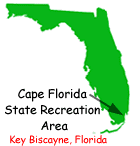|

Reservations for
Florida State
Parks are now
made through
Reserve America,
toll free, at
1-800-326-3521
|
BILL BAGGS CAPE FLORIDA STATE
PARK
HISTORY
 When Ponce
de Leon led the first Spanish expedition in 1513 to the land he called
Florida, he visited this area and named it the "Cape of Florida."
It was an area of ferocious storms and uncharted waters. Hidden sandbars
and submerged reefs, were a hazard to early sailors, causing hundreds
of shipwrecks along the Straits of Florida. For this reason, one of the
federal governments's first actions when Florida became a U.S. Territory
in 1821, was to plan for the extension of a network of lighthouses along
the east coast of Florida. When Ponce
de Leon led the first Spanish expedition in 1513 to the land he called
Florida, he visited this area and named it the "Cape of Florida."
It was an area of ferocious storms and uncharted waters. Hidden sandbars
and submerged reefs, were a hazard to early sailors, causing hundreds
of shipwrecks along the Straits of Florida. For this reason, one of the
federal governments's first actions when Florida became a U.S. Territory
in 1821, was to plan for the extension of a network of lighthouses along
the east coast of Florida.
In 1825,
the Cape Florida Lighthouse was built to serve as an important link in
this network of navigational aids. The lighthouse is the oldest building
in south Florida. With the outbreak of the Second Seminole War in 1835,
bloody encounters between the Seminole Indians and settlers to the area
spread throughout the peninsula. By July of 1836, the threat of attack
had caused the settlers to flee the mainland and take up temporary residence
on one of the better protected keys to the south.
Late in the afternoon of July
23, 1836, the Cape Florida Lighthouse was attacked and severely damaged
by fire. The Assistant Lighthouse Keeper miraculously survived and was
rescued by the crew of a Navy schooner. His helper, however, was killed.
The lighthouse remained out of service for the balance of the Second Seminole
War which ended in 1842.
By 1846, Congress had appropriated
$23,000 for reconstruction of the lighthouse. On April 30, 1847, Cape
Florida Lighthouse was "re-lit" for the first time. In 1855,
the height of the structure was increased from 65 to 95 feet and a 2nd
Order Fresnel lens was installed. In 1861, Confederate sympathizers removed
the lamps and burners and smashed the crucial center prism so it could
not be used as an aid to Union sailors who controlled the surrounding
waters. The lighthouse was repaired and re-lit again in 1866.
Finally, when nearby Fowey Rocks
Light was placed into service in 1878, the lens and illuminating apparatus
atop the lighthouse were removed and shipped to Staten Island, NY. One hundred
years later, on July 4, 1978, the light was reinstalled by the U. S. Coast
Guard to again serve as a navigational aid.
RESTORATION
Named after the late Miami newspaper editor who championed this area for
a state park, Bill Baggs Cape Florida SRA is part of a large barrier island
ecosystem. Following Hurricane Andrew in 1992, an extensive restoration
program was undertaken. The goal of the program is to restore the natural
plant communities and systems historically associated with the island.
RECREATION & RESOURCES
Whether it's a relaxing day at the beach, a visit to the historic lighthouse
or an afternoon of saltwater fishing, Cape Florida State Park offers visitors an
outstanding, outdoor recreational experience.
- The park provides a valued
retreat for urban residents who wish to escape the city to experience
the Real Florida.
- Voted one of the "Top
10 Beaches in the U.S.", the park's 1.25 miles of wide, sandy beachfront
offers visitors exceptional Atlantic swimming year-round.
- Some of the best shoreline
fishing in the region is available from the seawall located along Biscayne
Bay.
- Saltwater fishing licenses
are required in Florida.
- 18 covered pavilions provide
shaded picnicking overlooking the Atlantic Ocean and Biscayne Bay.
- "The
Lighthouse Cafe" offers visitors casual oceanfront dining in a
relaxed open-air setting. The concession offers a variety of rentals
including bicycles, Hydrobikes, rollerblades, ocean kayaks, windsurfers,
beach chairs and umbrellas. The adjoining Gift Shop features a variety
of quality gift items including souvenir T-shirts, postcards, film and
beach sundries.
- Guided tours of the Lighthouse
and Cultural Complex are available.
- Overnight boat mooring is
available in "No Name Harbor." Check with the park office
for rates and availability.

Bill Baggs
Cape Florida State Park is located on Key Biscayne. From Miami, take
I-95 to the Rickenbacker Causeway, all the way to the end.
For more information, contact:
Bill Baggs Cape Florida State Park
1200 S. Crandon Blvd.
Key Biscayne, Florida 33149
305/361-5811
View Larger Map
|



